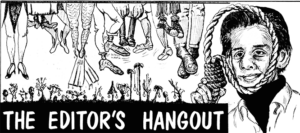 For as long as I can remember I have always liked weird stuff. Weird movies (anything scifi or supernatural), weird songs, weird books, and weird TV (The Twilight Zone was my favorite for years). Back in the early 1960s, when I was a teen, I somehow (I don’t remember how or where) discovered fandom. Long before there were blogs, tweets, Facebook, the internet, or personal computers, there was something called fandom. Fandom was made up of only a few thousand people, some of who published their own short run magazines called fanzines. Most of these publications were printed in the publisher’s home, on a tabletop ditto or mimeograph machine (no copiers back then). Fanzines came in different flavors, but I was mainly interested in those about sci-fi & horror movies or comic books. Eventually, I too published a fanzine I called Weirdom. The “Editor’s Hangout” art (by Dave Ludwig) at the beginning of this page was first published in Weirdom, back in 1967.
For as long as I can remember I have always liked weird stuff. Weird movies (anything scifi or supernatural), weird songs, weird books, and weird TV (The Twilight Zone was my favorite for years). Back in the early 1960s, when I was a teen, I somehow (I don’t remember how or where) discovered fandom. Long before there were blogs, tweets, Facebook, the internet, or personal computers, there was something called fandom. Fandom was made up of only a few thousand people, some of who published their own short run magazines called fanzines. Most of these publications were printed in the publisher’s home, on a tabletop ditto or mimeograph machine (no copiers back then). Fanzines came in different flavors, but I was mainly interested in those about sci-fi & horror movies or comic books. Eventually, I too published a fanzine I called Weirdom. The “Editor’s Hangout” art (by Dave Ludwig) at the beginning of this page was first published in Weirdom, back in 1967.
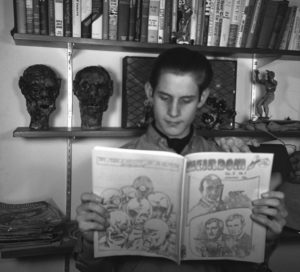 My late great Dad, Walt Cunningham helped and encouraged me on my early publishing projects, and he illustrated the covers for the 2 first issues. The first issue of Weirdom was printed via the hectograph method. I melted a gelatin mixture and poured it into a cookie pan. After it cooled it had a hard, rubbery feel. I used spirit duplicator carbon papers as my masters that I could type on in a typewriter and or draw on. The carbon papers came in different colors so multiple colors could be printed at the same time by using different colored carbons on the same transfer paper. I smoothed the transfer paper on to the gelatin and let it set for a few minutes (the carbon dyes transferred to the gelatin), then I pulled it off. To print each page I had to smooth a sheet of paper onto the gelatin, then peel it off. When I was done with that side of a page, I had to wait a couple hours for the gelatin to clear and repeat the procedure for the remaining pages. This method won’t print very many copies, so that first issue had a run of under 50. Needless to say, this was a slow and tedious process. If they had photo copy machines back then, it would have been a lot easier!
My late great Dad, Walt Cunningham helped and encouraged me on my early publishing projects, and he illustrated the covers for the 2 first issues. The first issue of Weirdom was printed via the hectograph method. I melted a gelatin mixture and poured it into a cookie pan. After it cooled it had a hard, rubbery feel. I used spirit duplicator carbon papers as my masters that I could type on in a typewriter and or draw on. The carbon papers came in different colors so multiple colors could be printed at the same time by using different colored carbons on the same transfer paper. I smoothed the transfer paper on to the gelatin and let it set for a few minutes (the carbon dyes transferred to the gelatin), then I pulled it off. To print each page I had to smooth a sheet of paper onto the gelatin, then peel it off. When I was done with that side of a page, I had to wait a couple hours for the gelatin to clear and repeat the procedure for the remaining pages. This method won’t print very many copies, so that first issue had a run of under 50. Needless to say, this was a slow and tedious process. If they had photo copy machines back then, it would have been a lot easier!
Fortunately my dad bought a used spirit duplicator (ditto machine) for both of us to use. He used it to produce flyers and newsletters for the magic club he belonged to. Printing the second issue was much easier. I used the same carbon masters that attached to the drum of the machine. An Absorbent wick in the machine would coat each sheet of paper with solvent so that when the sheet came into contact with the master, some of the wax ink would transfer to the paper. I would place a small stack of paper in the feeder, and every turn of the handle would print a page. I would learn the hard way that some colors would provide a longer run than others. The purple ink lasted the longest, and people who went to school in the 50’s-60’s probably remember their teachers handing out work sheets in this color, and might even remember the solvent smell on the paper.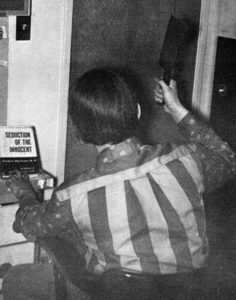
While the ditto machine was a big improvement over the hectagraph, it was limited to how many copies could be produced. Anything over 100 would start to produce undesirable lighter copies. For this reason, with issue #7, I bought a used mimeograph machine and started transitioning to this process. Mimeograph is a stencil printing process and while it only prints in black ink, it would print hundreds of more copies than the ditto machine. The problem here was that Weirdom was transitioning into a comics fanzine and the mimeograph process didn’t reproduce comics very well. I always envied the few fanzines that were offset printed (the Cadillac of printing). This offset envy would ultimately shape my future occupation.
When I was in high school I had the option to go to a vocational center for half the school-day and learn a trade. It’s not surprising I chose printing as my trade. Most of my classmates went there to goof off, but I was one of the few who actually wanted to learn. This didn’t go unnoticed by my printing instructor so it wasn’t hard for me to talk him into letting me print Weirdom there. Issues #’s 10 & 11 were printed at the vocational center on a multilith. I just paid for the supplies, and my long dream of having Weirdom offset printed came true. Looking back, I can see the printing was not A1 quality because I was still learning and hadn’t yet mastered pre-press & press machines. After graduating from high school, I worked in a small 2 man print shop in San Jose. The boss liked me & let me print Weirdom #’s 12 and 13 at the shop in the evening.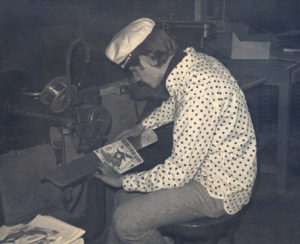
1968 was a time when the war in Vietnam was revving up, there was a draft, and I was classified A1. I could have played it smarter (bone spurs?), but in late 1968 the Army got me. I worked in an Army hospital, seeing the casualties of war (and only the ones on our side), focused my anti war feelings. Later I would write some anti war cartoons (e.g. the cover of Weirdom #14, illustrated by Richard Corben).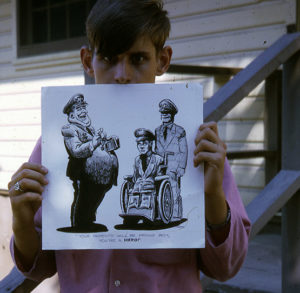
When I got out of the Army in 1971, I got back into the comic book scene. New in comics was something I hadn’t seem before; underground comics. I thought I might try my luck with this format, but it would be more expensive than before. Going from a print run of 1,000 for Weirdom 13, to a run of 10,000 for Weirdom 14 would cost me all of my savings. I would go on to publish Weirdom 14 and 15 and Tales From The Plague in this new format. Unfortunately, this form of publishing wasn’t doing me well financially, so I threw in the towel.
This was a time when the Santa Clara Valley (now known as Silicon Valley) where I grew up was growing rapidly. There were too many cars and too much smog. I decided to live another life dream and move north to the country. It was Lake County where the air was clean and there were no freeways and not even a stop light in the entire county! I spent over a decade in Lake County, a few years in Butte County, and going on 20 years in Humboldt County, where I now live.
Long ago I gave up publishing, but I never lost my love for comics, especially those from the golden age. Now that I’m retired and have more time on my hands, I’ve decided to publish a series of Golden Age Of Comics books; you can check them out on the home page.
Dennis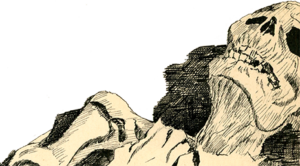
A big thank you to all the talented people who helped make Weirdom possible.
Jim Boxell
Roger Brand
John Brunas
John H. Carpenter
Al Castle
Johnny Chambers
Richard Corben
John Cornado
Walt Cunningham
John R. Duvoli
Jim Farrell
Jerry Firitilli
Lauren T. Flemming
Rudy Franke
Leonard Freedman
Jim Garrison
Dennis Harden
Dave Herring
Ken Lodge
Dave Ludwig
Dennis Milecki
Lon Mitchell
Mark Nelson
Loren Ratzlaff
Chuck Rogers
Martin Russel
Harald Sommerfeldt
Bill Spicer
Omar Torres
Frank Widman
John A. Williams
Don Williamson
Donald Willis
Dave Wilson
Mark Wilson
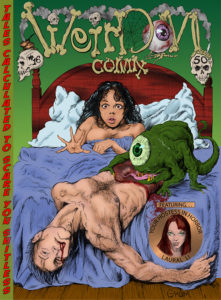
Unpublished cover to
Weirdom 16. Art by John
Williams & color by myself.
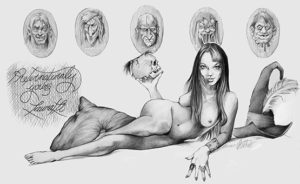
Dave Ludwig created Laural Li,
Weirdom’s sexy “hostess In
Horror” about 2½ years before
Vampirella was published,
when she first appeared on the
Weirdom #10 cover. Above
John Williams created the
center spread for Weirdom #14

